Download Vindemiatrix (ε Virginis) Worksheets
Click the button below to get instant access to these premium worksheets for use in the classroom or at a home.
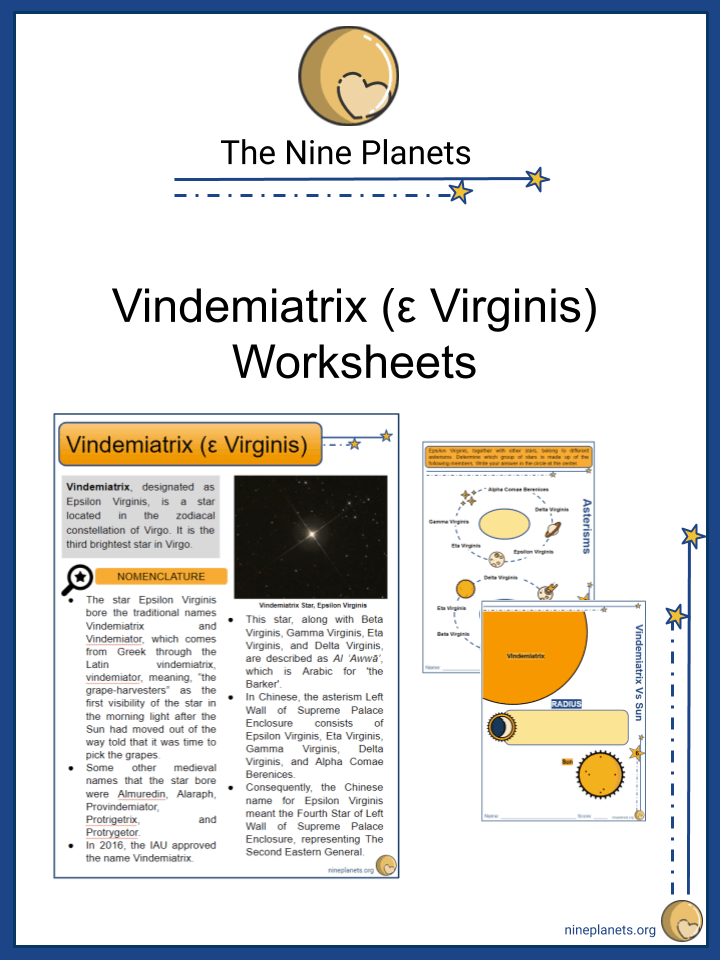
This worksheet can be edited by Premium members using the free Google Slides online software. Click the Edit button above to get started.
Download free sample
Not ready to purchase a subscription yet? Click here to download a FREE sample of this worksheet pack.
Resource Examples
Click any of the example images below to view a larger version.
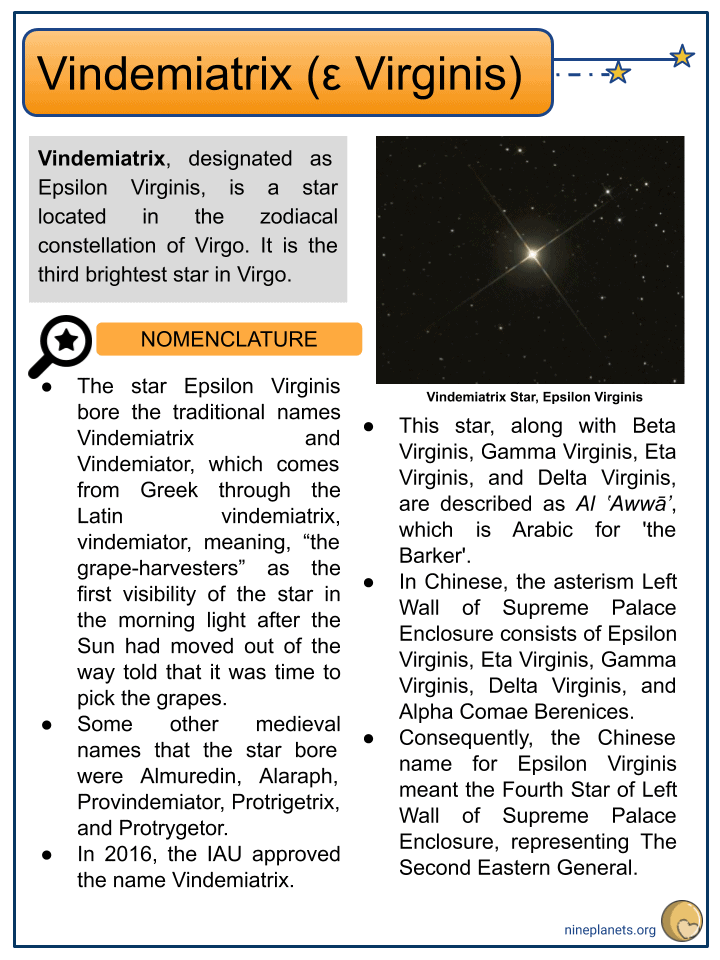
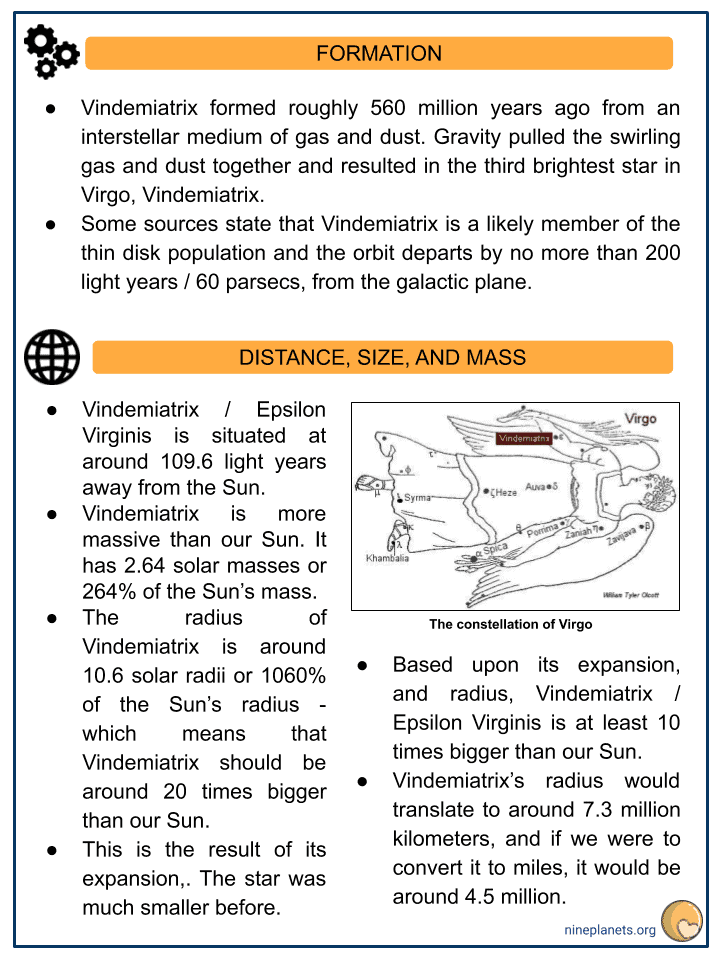
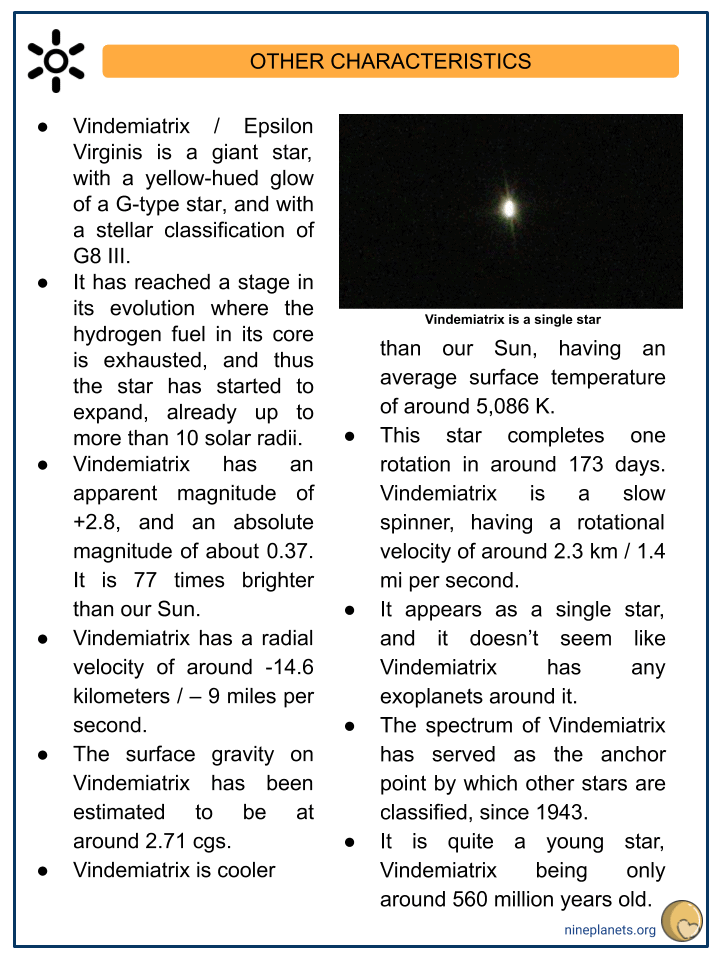
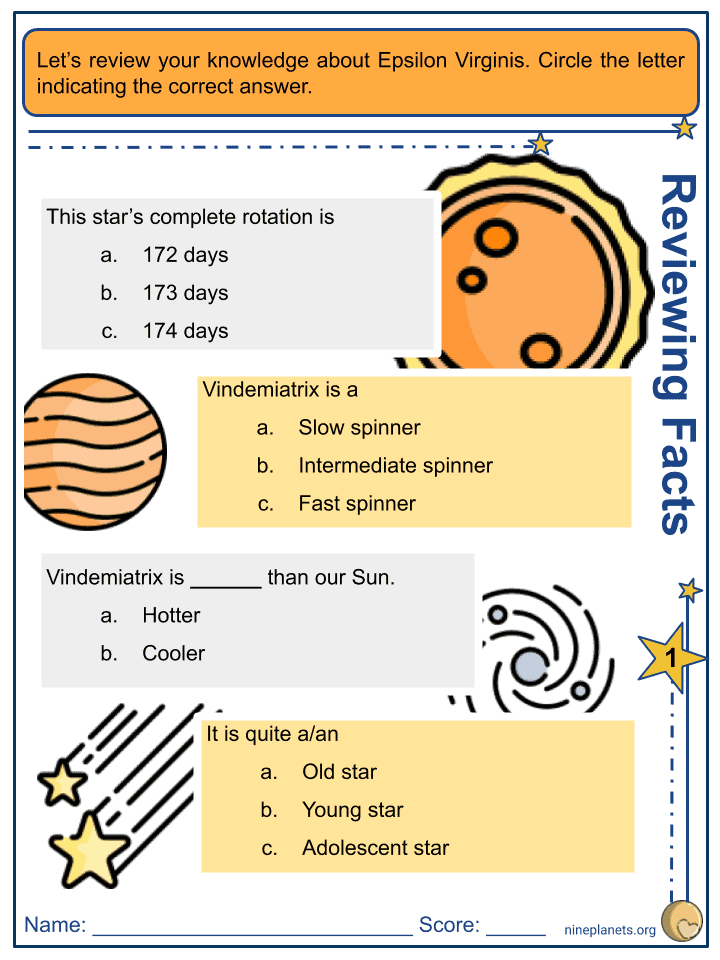
Key Facts & Information
- Vindemiatrix, designated as Epsilon Virginis, is a star located in the zodiacal constellation of Virgo. It is the third brightest star in Virgo.
Nomenclature
- The star Epsilon Virginis bore the traditional names Vindemiatrix and Vindemiator, which comes from Greek through the Latin vindemiatrix, vindemiator, meaning, “the grape-harvesters” as the first visibility of the star in the morning light after the Sun had moved out of the way told that it was time to pick the grapes.
- Some other medieval names that the star bore were Almuredin, Alaraph, Provindemiator, Protrigetrix, and Protrygetor.
- In 2016, the IAU approved the name Vindemiatrix.
- This star, along with Beta Virginis, Gamma Virginis, Eta Virginis, and Delta Virginis, are described as Al ʽAwwāʼ, which is Arabic for ‘the Barker’.
- In Chinese, the asterism Left Wall of Supreme Palace Enclosure consists of Epsilon Virginis, Eta Virginis, Gamma Virginis, Delta Virginis, and Alpha Comae Berenices.
- Consequently, the Chinese name for Epsilon Virginis meant the Fourth Star of Left Wall of Supreme Palace Enclosure, representing The Second Eastern General.
Formation
- Vindemiatrix formed roughly 560 million years ago from an interstellar medium of gas and dust. Gravity pulled the swirling gas and dust together and resulted in the third brightest star in Virgo, Vindemiatrix.
- Some sources state that Vindemiatrix is a likely member of the thin disk population and the orbit departs by no more than 200 light years / 60 parsecs, from the galactic plane.
Distance, Size, And Mass
- Vindemiatrix / Epsilon Virginis is situated at around 109.6 light years away from the Sun.
- Vindemiatrix is more massive than our Sun. It has 2.64 solar masses or 264% of the Sun’s mass.
- The radius of Vindemiatrix is around 10.6 solar radii or 1060% of the Sun’s radius – which means that Vindemiatrix should be around 20 times bigger than our Sun.
- This is the result of its expansion,. The star was much smaller before.
- Based upon its expansion, and radius, Vindemiatrix / Epsilon Virginis is at least 10 times bigger than our Sun.
- Vindemiatrix’s radius would translate to around 7.3 million kilometers, and if we were to convert it to miles, it would be around 4.5 million.
Other Characteristics
- Vindemiatrix / Epsilon Virginis is a giant star, with a yellow-hued glow of a G-type star, and with a stellar classification of G8 III.
- It has reached a stage in its evolution where the hydrogen fuel in its core is exhausted, and thus the star has started to expand, already up to more than 10 solar radii.
- Vindemiatrix has an apparent magnitude of +2.8, and an absolute magnitude of about 0.37. It is 77 times brighter than our Sun.
- Vindemiatrix has a radial velocity of around -14.6 kilometers / – 9 miles per second.
- The surface gravity on Vindemiatrix has been estimated to be at around 2.71 cgs.
- Vindemiatrix is cooler than our Sun, having an average surface temperature of around 5,086 K.
- This star completes one rotation in around 173 days. Vindemiatrix is a slow spinner, having a rotational velocity of around 2.3 km / 1.4 mi per second.
- It appears as a single star, and it doesn’t seem like Vindemiatrix has any exoplanets around it.
- The spectrum of Vindemiatrix has served as the anchor point by which other stars are classified, since 1943.
- It is quite a young star, Vindemiatrix being only around 560 million years old.
- The star seems to be about 15% richer than the Sun in metals, and is somewhat distinguished by having most of its motion in the direction perpendicular to the line of sight, making it appear to move rather rapidly against the background stars.
- Much more significantly, Vindemiatrix is a rather powerful X-ray source, implying considerable magnetic surface activity.
- Its total X-ray radiation is almost 300 times that of the Sun, ranking it third among nearby cool single giants and beaten only by Beta Ceti (2,000 times) and Ursae Majoris, which lies northeast of the bowl of the Big Dipper.
- Though Vindemiatrix has surely ceased fusing hydrogen to helium in its core, its exact internal structure is uncertain.
- At three solar masses, it probably began life as a blue-white class B star, and is now either in transition to beginning to fire up its internal helium or has already begun to do so.
Location
- Vindemiatrix / Epsilon Virginis is located in the zodiacal constellation of Virgo as a bright yellow star in the right wing, or right arm, of the Virgin.
- It is the third brightest star after first magnitude Spica (Alpha Star) and Porrima (Gamma). The beta star (Zavijava) shines only as fourth brightest.
- The constellation of Virgo is the second largest in the night sky, after Hydra, and the largest zodiacal constellation.
- It is one of the Greek constellations, first listed by the Greek astronomer Ptolemy, in the 2nd century C.E. The Virgo constellation contains 11 Messier objects.
- The star 70 Virginis has one of the first known extrasolar planetary systems, with one confirmed planet 7.5 times the mass of Jupiter.
- Another star, 61 Virginis, is very similar to our Sun and has three planets orbiting it – one is a super-Earth, and two are Neptune-mass planets.
- There are many more interesting stars, exoplanets, many galaxies, and other deep-sky objects in the constellation of Virgo.
- The best time to observe them is during the month of May.
- If you want to hunt for galaxies, there is a galaxy cluster here, consequently called the Virgo Cluster, 5 at 12 degrees west of Vindemiatrix.
- The star can be seen with the naked eye, that is, you don’t need a telescope/binoculars to see it.
The Future
- Vindemiatrix / Epsilon Virginis will continue to survive for many millions of years. It has reached a stage in its evolution where the hydrogen fuel in its core is exhausted, and thus the star has started to expand and will continue to do so for a long time before moving on to a different stage.